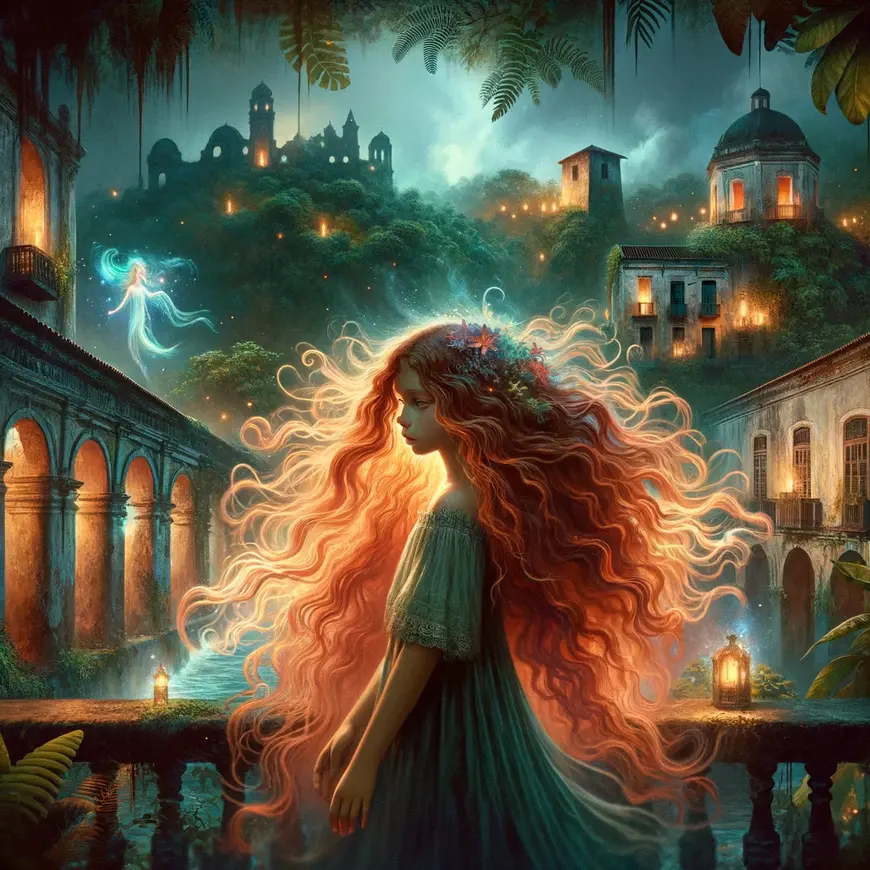The Depths of Passion and Madness: A Journey through “Of Love and Other Demons”
What I found in the Depths of “Of Love and other Demons” by Gabriel Garcia Marquez
Reading “Of Love and Other Demons” by Gabriel García Márquez meant experiencing something ethereal, poignant—its magic realism was gently swirling me through the world of fateful human reflections and life. The book, set in a unnamed South American colony against the background of the Spanish Inquisition, relates tragic, mystic events of a young girl, Sierva Maria, who, once bitten by a mad dog, was considered possessed by demons.
The first page of the book captures the reader by lively descriptions with lush prose, painting a truthful picture of a colonial society full of superstitions and fear by Garcia Marquez.
I couldn’t help but relate to the strong feelings of the characters that followed their doom-filled love story, the alien elements that really seemed to confuse dreams with reality.
Finishing the book left me in awe at how human García Márquez must have been to weave a story that very well exposed the extremes of human behaviors and beliefs. “Of Love and Other Demons” is evocative and powerful, a novel that lingers in your mind well after you have turned the last page.
The Enigma of Sierva Maria: A Love Born from Madness
Gabriel Garcia Marquez‘s “Of Love and Other Demons” is a mesmerizing tale that delves into the complex interplay of love, obsession, and the supernatural. Set against the backdrop of a South American colony in the 18th century, the novel weaves a rich tapestry of characters, each entangled in a web of forbidden desires and societal constraints. Marquez, a Colombian Nobel laureate known for his mastery in magical realism, explores themes of love, madness, and the transcendent power of human connections in this unforgettable narrative. This review aims to peel back the layers of Marquez’s work, examining the nuanced characters, the setting’s vibrant yet haunting atmosphere, and the narrative’s overarching themes. Through simple language, we will embark on a journey to understand the allure and the criticisms of this novel, ultimately appreciating its place in the pantheon of literary classics.
At the heart of the novel is Sierva Maria, a young girl bitten by a rabid dog, feared by her community to be possessed by demons. Her ensuing imprisonment in a convent, designed to exorcise her supposed demons, serves as a dark reflection of the era’s superstitions and the brutal ways in which society seeks to control that which it does not understand. Sierva Maria’s character is a complex blend of innocence and wisdom, her foreign mannerisms and language acquired from her upbringing among African slaves, setting her apart from her community. Her supposed affliction brings her into contact with Father Cayetano Delaura, a priest tasked with her exorcism, who becomes infatuated with her. Their love, both profound and doomed, challenges the boundaries of faith and reason.
Father Cayetano Delaura: The Tormented Lover
Father Cayetano Delaura, the embodiment of the novel’s exploration of obsession and love, is a character who undergoes a profound transformation. Initially presented as a man of faith, his encounter with Sierva Maria sparks a conflict between his priestly vows and his uncontrollable passion. This internal struggle is one of the novel’s central tensions, showcasing Marquez’s skill in portraying the complexities of the human heart. The priest’s descent into obsession serves as a poignant commentary on the nature of love as both a redemptive and destructive force.

A Tapestry of Themes: Love, Madness, and Oppression
“Of Love and Other Demons” is rich with themes that resonate through its narrative. Marquez explores love beyond romantic desire. He comments on human connection and isolation. The love between Sierva Maria and Cayetano, fraught with obstacles, speaks to the universal quest for understanding and companionship. This quest occurs in a world that often fosters division.
Moreover, madness, both real and perceived, plays a critical role in the novel. Marquez blurs the lines between sanity and insanity. He suggests that madness might be profound insight or resistance against societal norms. Sierva Maria’s “possession” and the attempts to cure her highlight the fine line between faith and superstition. This also emphasizes the tension between rationality and madness.
Furthermore, Marquez’s setting is a character in its own right. It vividly portrays a colonial world filled with beauty and brutality. The contrast between the nobility’s opulent lifestyle and the harsh realities of slavery and poverty serves as a backdrop to the novel’s events. Additionally, Marquez uses magical realism to blur the boundaries between the mundane and the miraculous. This creates a world where the supernatural feels as real as the historical context.
The Setting: A World of Contrasts
Marquez’s setting acts as a character in its own right. It vividly portrays a colonial world filled with beauty and brutality. Additionally, the contrast between the nobility’s opulent lifestyle and the harsh realities of slavery and poverty serves as a backdrop to the novel’s events. Furthermore, Marquez’s use of magical realism blurs the boundaries between the mundane and the miraculous. This creates a world where the supernatural feels as real as the historical context.
Style and Narrative Technique: The Magic of Marquez
Marquez’s narrative style is a key element of the novel’s charm. Moreover, his use of magical realism enriches the story’s texture. This literary mode makes magical elements a natural part of an otherwise mundane world. His lyrical prose, filled with vivid imagery and rich symbolism, transports readers into the heart of his created world. The nonlinear narrative weaves between past and present, dreams and reality. Consequently, it deepens the mystery and complexity surrounding the characters’ lives.
Famous Quotes from “Of Love and other Demons” by Gabriel Garcia Marquez
- “Disbelief is more resistant than faith because it is sustained by the senses.”
- This quote reflects on the nature of faith versus skepticism. García Márquez suggests that disbelief or skepticism often feels more robust and enduring than faith because it is grounded in what we can see, hear, and touch. In a world where the supernatural intertwines with the everyday, this quote challenges characters and readers alike to consider the limitations of relying solely on the senses to determine reality.
- “There is no greater glory than to die for love.”
- This dramatic declaration captures the novel’s central theme: the power and tragedy of love. The characters, particularly Sierva Maria and Father Cayetano, find themselves caught in a love that society deems forbidden.
- “Age isn’t how old you are but how old you feel.”
- This quote touches on the novel’s exploration of age, maturity, and the spirit’s agelessness.
- “Nothing is more difficult than loving.”
- Love is a central motif in “Of Love and Other Demons,” and this quote succinctly captures its complexity and challenges. The novel presents love as a force of great power and peril, capable of inspiring profound joy and devastating heartache. This statement underscores the courage and resilience required to love, especially in the face of societal norms and obstacles.
- “The only regret I will have in dying is if it is not for love.”
- It speaks to the character’s belief in love as the most noble cause for which one can live—or die. This quote encapsulates the passion and intensity of the characters’ feelings, highlighting the sacrificial nature of true love.

Trivia Facts about “Of Love and other Demons”
- Inspired by a Real-life Event: The novel was inspired by an event that García Márquez witnessed as a young journalist in 1949.
- A Blend of Genres: Although often categorized as a work of magical realism, the novel also blends elements of gothic fiction, historical fiction, and tragedy. This amalgamation of genres contributes to its unique atmosphere, merging the haunting qualities of gothic tales with the rich cultural and historical backdrop of colonial South America.
- Personal Connections: Gabriel García Márquez once mentioned that all his books were a letter of love to his wife, Mercedes Barcha. This novel, steeped in themes of love and sacrifice, can be seen as a reflection of the deep affection he felt for her, showcasing the enduring power of love in the face of adversity.
- Influence of García Márquez’s Journalism Background: Before becoming a Nobel laureate in literature, García Márquez was a journalist. His journalistic background influenced his writing style, characterized by meticulous attention to detail and a profound understanding of human nature. This foundation is evident in the vivid descriptions and complex characterizations within “Of Love and Other Demons”.
- A Story of Unconventional Love: At its core, the novel is a poignant exploration of forbidden love and societal boundaries.
- Magical Realism as a Reflection of Reality: García Márquez’s use of magical realism—a style where magical elements are presented as part of the ordinary world—serves as a lens through which the realities of Latin American life are amplified and explored.
Critical Reception and Legacy
“Of Love and Other Demons” has been both praised and critiqued for its themes, style, and emotional depth. Critics laud Marquez’s ability to blend the real with the fantastical, creating a narrative that is at once poignant and profound. However, some have argued that the novel’s pacing and structure can be disorienting, occasionally obscuring the narrative’s core themes. The novel remains a testament to Marquez’s enduring legacy as one of the literary giants of the 20th century.
Conclusion: A Timeless Exploration of the Human Condition
Gabriel Garcia Marquez’s “Of Love and Other Demons” transcends its historical setting. It offers readers a timeless exploration of love, madness, and the desire for connection. Through the tragic tale of Sierva Maria and Father Cayetano, Marquez invites us to reflect on our own demons. These demons may be love, obsession, or societal chains that bind us.
Moreover, this novel, with its rich narrative and complex characters, stands as a profound meditation on the human condition. It reminds us of the power of literature. Additionally, it illuminates the darkest corners of our souls. Therefore, “Of Love and Other Demons” is a timeless exploration of our deepest fears and desires.
More Reviews of Works by Gabriel Garcia Marquez
“Love in the Time of Cholera” by Gabriel Garcia Marquez: A Timeless Tale of Love, Longing, and Redemption My summarized…
“One Hundred Years of Solitude” by Gabriel Garcia Marquez: A Timeless Tapestry of Magic and Reality Gabriel Garcia Marquez’s “One…

